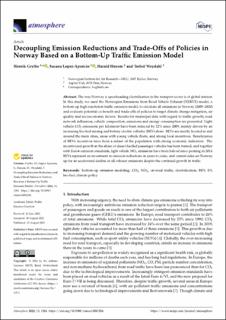| dc.contributor.author | Grythe, Henrik | |
| dc.contributor.author | Lopez-Aparicio, Susana | |
| dc.contributor.author | Høyem, Harald | |
| dc.contributor.author | Weydahl, Torleif | |
| dc.date.accessioned | 2022-08-25T09:12:30Z | |
| dc.date.available | 2022-08-25T09:12:30Z | |
| dc.date.created | 2022-08-17T15:01:53Z | |
| dc.date.issued | 2022 | |
| dc.identifier.citation | Atmosphere. 2022, 13, 1284. | en_US |
| dc.identifier.issn | 2073-4433 | |
| dc.identifier.uri | https://hdl.handle.net/11250/3013484 | |
| dc.description.abstract | The way Norway is spearheading electrification in the transport sector is of global interest. In this study, we used the Norwegian Emissions from Road Vehicle Exhaust (NERVE) model, a bottom-up high-resolution traffic emission model, to calculate all emissions in Norway (2009–2020) and evaluate potential co-benefit and trade-offs of policies to target climate change mitigation, air quality and socioeconomic factors. Results for municipal data with regard to traffic growth, road network influences, vehicle composition, emissions and energy consumption are presented. Light vehicle CO2 emissions per kilometer have been reduced by 22% since 2009, mainly driven by an increasing bio-fuel mixing and battery electric vehicles (BEV) share. BEVs are mostly located in and around the main cities, areas with young vehicle fleets, and strong local incentives. Beneficiaries of BEVs incentives have been a subset of the population with strong economic indicators. The incentivized growth in the share of diesel-fuelled passenger vehicles has been turned, and together with Euro6 emission standards, light vehicle NOx emissions have been halved since peaking in 2014. BEVs represent an investment in emission reductions in years to come, and current sales set Norway up for an accelerated decline in all exhaust emissions despite the continual growth in traffic. | en_US |
| dc.language.iso | eng | en_US |
| dc.rights | Navngivelse 4.0 Internasjonal | * |
| dc.rights.uri | http://creativecommons.org/licenses/by/4.0/deed.no | * |
| dc.title | Decoupling Emission Reductions and Trade-Offs of Policies in Norway Based on a Bottom-Up Traffic Emission Model | en_US |
| dc.title.alternative | Decoupling Emission Reductions and Trade-Offs of Policies in Norway Based on a Bottom-Up Traffic Emission Model | en_US |
| dc.type | Peer reviewed | en_US |
| dc.type | Journal article | en_US |
| dc.description.version | publishedVersion | en_US |
| dc.rights.holder | © 2022 by the authors. Licensee MDPI, Basel, Switzerland. | en_US |
| dc.source.volume | 13 | en_US |
| dc.source.journal | Atmosphere | en_US |
| dc.identifier.doi | 10.3390/atmos13081284 | |
| dc.identifier.cristin | 2043898 | |
| dc.relation.project | NILU - Norsk institutt for luftforskning: 120011 | en_US |
| dc.relation.project | NILU - Norsk institutt for luftforskning: 117112 | en_US |
| dc.relation.project | NILU - Norsk institutt for luftforskning: 119085 | en_US |
| dc.relation.project | NILU - Norsk institutt for luftforskning: 106057 | en_US |
| dc.source.articlenumber | 1284 | en_US |
| cristin.ispublished | true | |
| cristin.fulltext | original | |
| cristin.qualitycode | 1 | |

